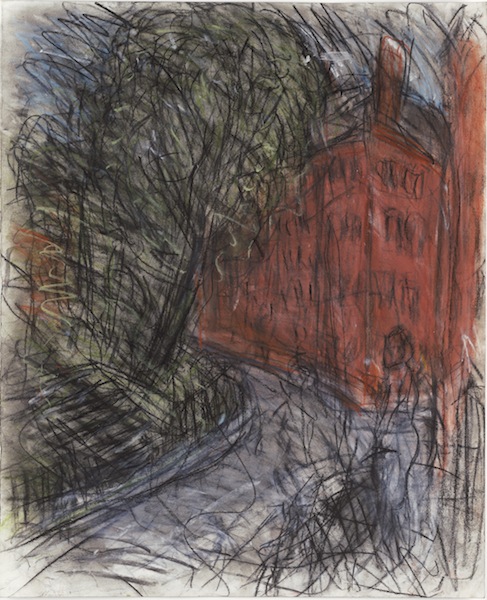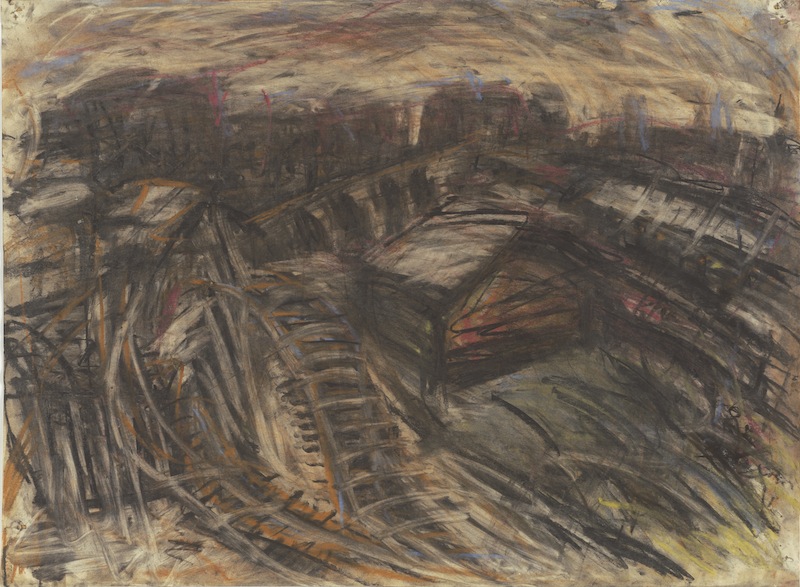Sixty years of hard work, encapsulated in 90 drawings and a handful of thickly encrusted paintings, by the distinguished, obsessive, single-minded octagenerian artist Leon Kossoff (b 1926) vividly set out a passionate attachment to a simultaneously immutable and ever changing London. An East Ender, Kossoff has had several subjects: he has painted people, and has continually drawn after the Old Masters, first visiting the National Gallery as a schoolchild. His drawings after Poussin were exhibited at the National Gallery. But here for the first time, is an exhibition concentrating on Kossoff’s London.
Working outside in all weathers, thick drawing paper attached to a large clipboard, Kossoff has looked at the resonances of his native city. People surging through underground stations, the old Hungerford Bridge looming over Embankment station, Kilburn underground, trains in the night, an ancient cherry tree carefully supported in its dotage, Hawksmoor’s Christ Church looming in its awesome grace, are some of his subjects, returned to again and again.
 He has made of London a surprisingly tangled web of lines deploying charcoal with varying amounts of pressure and a range of pastels, colours always subtle as though emerging through diffused light, our polluted skies making for absorbing visual effects. The sun never dominates. Those rare days when London has a New York sky of blazing blue holds no appeal for Kossoff.
He has made of London a surprisingly tangled web of lines deploying charcoal with varying amounts of pressure and a range of pastels, colours always subtle as though emerging through diffused light, our polluted skies making for absorbing visual effects. The sun never dominates. Those rare days when London has a New York sky of blazing blue holds no appeal for Kossoff.
This is old London, continuing to renew itself, reminding us that the postwar period has seen almost as much destruction and renewal as the Victorian, both building on the voids left by the blitz, and gasping for modernity in the strange new post-imperial world. The light is pearly, grey, softly blue, the winter sun gleaming, iridescent. Close up to any drawing, there is but a skein of lines. At a little distance shapes loom and a surprising number of people turn up, scurrying in the street, buying their train tickets or wheeling bicycles. (Pictured above right: Arnold Circus, 2008-10; charcoal and pastel on paper).
Kossoff’s London is always in a bit of disarray, functioning in a kind of workable controlled chaos. Like a living creature the city all is nervous tension. The presence of people is always evident, either actually there, as in the crowded children’s swimming pool, or suggested, for every image is centred on something manmade, from trains to city streets, buildings to bridges.
 He captures what is also peculiar to London – a sense of expectancy. Perhaps it is the continually variable weather and sky, so characteristic of this city. The artefacts of the city, from trainlines to building sites, seem almost as variable as the weather, and yet are also steadfast in their dignified appearance. What Kossoff gives us is not London as a shambles, but London as a resonant, living organism in which its buildings, in whatever state of being, act as both core and backdrop, skeleton and body, scenery and actor, in interchanges with the human inhabitants.
He captures what is also peculiar to London – a sense of expectancy. Perhaps it is the continually variable weather and sky, so characteristic of this city. The artefacts of the city, from trainlines to building sites, seem almost as variable as the weather, and yet are also steadfast in their dignified appearance. What Kossoff gives us is not London as a shambles, but London as a resonant, living organism in which its buildings, in whatever state of being, act as both core and backdrop, skeleton and body, scenery and actor, in interchanges with the human inhabitants.
It is an astonishing achievement, to make of London, and mostly of its more humble neighbourhoods, something so grand and so approachable. The unplanned confusion of Dalston Lane is treated with as much care as the architectural glory of Hawksmoor’s Christ Church. The artist himself, seeing the array of work before him, has confessed to being surprised and delighted by where he has been, and what he has seen (surprising for a man so personally reticent, who is rarely interviewed, and has in the past even disliked being written about). (Pictured above left: York Way, charcoal and pastel on paper).
His idiom harks back in certain ways to expressionism: the deep colours, a sense sometimes of violent change, and yet there is a sense of exquisite pleasure of the moment. The 10 or so paintings of the same subjects, deeply encrusted, thick paint in skeins of colour, brush and palette knife to the fore, are strikingly solid; the atmosphere is dense, and even when the scene is outdoors, there is a sense of enclosure, of being wrapped round by the scene. The drawings, though, almost dance and somehow communicate just that smoky smell of the air, the pause before rain.
This unmissable anthology of a major artist makes us see and feel the presence of London, anew and afresh.










![SEX MONEY RACE RELIGION [2016] by Gilbert and George. Installation shot of Gilbert & George 21ST CENTURY PICTURES Hayward Gallery](/sites/default/files/styles/thumbnail_125_x_125_/public/mastimages/Gilbert%20%26%20George_%2021ST%20CENTURY%20PICTURES.%20SEX%20MONEY%20RACE%20RELIGION%20%5B2016%5D.%20Photo_%20Mark%20Blower.%20Courtesy%20of%20the%20Gilbert%20%26%20George%20and%20the%20Hayward%20Gallery._0.jpg?itok=3oW-Y84i)




Add comment